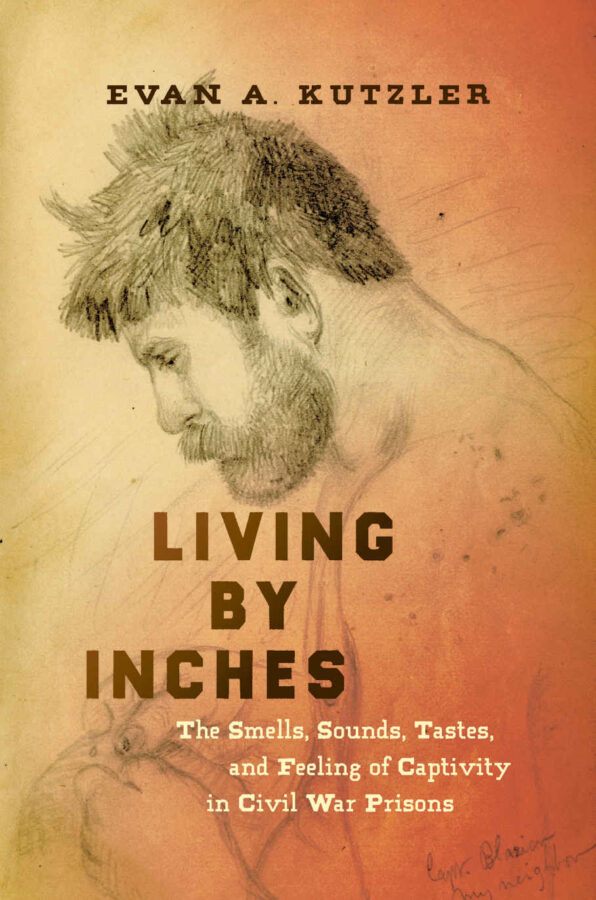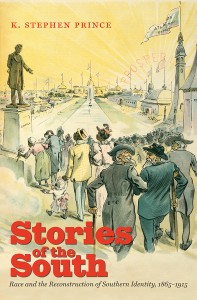Living By Inches: The Smells, Sounds, Tastes, and Feeling of Captivity in Civil War Prisons by Evan A. Kutzler. University of North Carolina Press, 2019. Paper, ISBN: 978-1469653785. $29.95.
 Despite many gloomy predictions, the sesquicentennial hardly proved the twilight of Civil War scholarship. To the contrary, the field may be entering its most fecund period to date as historians embrace the possibilities of new approaches and new methodologies. Recent scholars have sought to understand how historical actors understood and made sense of the war around them through histories of the environment, the emotions, and material culture. Amy Murrell Taylor’s Embattled Freedom [2018] reoriented our understanding of emancipation by taking us on a “journey” through the war’s slave refugee camps. By revealing where freedom-seeking enslaved persons lived, what they consumed, and how they were clothed, Taylor did not merely lend color or context to the narrative of escaping slavery in a time of war; rather, the maw of experience became the story. Martha Hodes’s Mourning Lincoln [2015] took seriously the full range of emotions unleashed by the Lincoln assassination. In the author’s deft hands, the raw confusion over Lincoln’s death and the conflicting ways in which people responded to it betrayed larger uncertainties over the end of the war and its ultimate meaning. Joan Cashin’s aptly titled War Stuff [2019], a history of human and material resources during the conflict, revealed the gap between “hard war” policies and lived experience on the ground. From the very beginning, Civil War armies privileged their own needs and stomachs above policy, prescription, or procedure. The question at the heart of these three books — how did ordinary people negotiate the experience of civil war? — opens up new spaces and new perspectives. By approaching the war as a contingent human experience rather than a linear sequence of events, we discover just how much traditional definitions, interpretations, and periodizations have obscured.
Despite many gloomy predictions, the sesquicentennial hardly proved the twilight of Civil War scholarship. To the contrary, the field may be entering its most fecund period to date as historians embrace the possibilities of new approaches and new methodologies. Recent scholars have sought to understand how historical actors understood and made sense of the war around them through histories of the environment, the emotions, and material culture. Amy Murrell Taylor’s Embattled Freedom [2018] reoriented our understanding of emancipation by taking us on a “journey” through the war’s slave refugee camps. By revealing where freedom-seeking enslaved persons lived, what they consumed, and how they were clothed, Taylor did not merely lend color or context to the narrative of escaping slavery in a time of war; rather, the maw of experience became the story. Martha Hodes’s Mourning Lincoln [2015] took seriously the full range of emotions unleashed by the Lincoln assassination. In the author’s deft hands, the raw confusion over Lincoln’s death and the conflicting ways in which people responded to it betrayed larger uncertainties over the end of the war and its ultimate meaning. Joan Cashin’s aptly titled War Stuff [2019], a history of human and material resources during the conflict, revealed the gap between “hard war” policies and lived experience on the ground. From the very beginning, Civil War armies privileged their own needs and stomachs above policy, prescription, or procedure. The question at the heart of these three books — how did ordinary people negotiate the experience of civil war? — opens up new spaces and new perspectives. By approaching the war as a contingent human experience rather than a linear sequence of events, we discover just how much traditional definitions, interpretations, and periodizations have obscured.
These historiographical musings supply some of the context for Evan A. Kutzler’s dazzling first monograph, Living By Inches: The Smells, Sounds, Tastes, and Feeling of Captivity in Civil War Prisons. Building on the work of his graduate advisor Mark Smith (The Smell of Battle, The Taste of Siege: A Sensory History of the Civil War), Kutzler renews the promise of Civil War sensory history. In five sprite chapters, he maps the haptic geography of the Civil War prison—one of the conflict’s most surreal spaces. Indeed, the “extremes” of Civil War prisons render these sites especially rewarding venues for sensory analysis. Pointing out that captives not infrequently wound their way from prison to prison, Kutzler does not limit his analysis to a single prison camp. Nor does he confine his study to southern or northern prisons. This last choice does not propose “parity” between the belligerents in prison conditions or prisoner treatment, but instead announces a key premise of the book: to chart “policy” alone is to obscure how prisoners literally felt their way through the ordeal of captivity (6, 106). While prisons were some of the deadliest places on the Civil War landscape—more men died at Andersonville than at Gettysburg—Kutzler is more interested in mechanisms of survival. “Searching for an explanation as to why so many men died,” he writes, “overlooks the human question of how so many lived” (5).
Kutzler opens with a striking chapter on captivity at night—the period in which “the nonvisual senses reached their full expression individually and in concert” (27). Darkness “disoriented,” but in doing so obliged prisoners to “[engage] in an interpretive process that gave meaning to the phenomena around them” (35). Night amplified sounds, silences, and smells—sensory clues that became vital tools in navigating the prison experience (or hatching plots for escape).
The second chapter foregrounds smell as a tool used by prisoners to “understand the landscape of captivity” (39). Antebellum ideas about the unwholesome effects of “foul air” shaped the way that prisoners conceived of their captivity and contributed to their feelings of “dehumanization.” Some prisoners developed “anosmia,” the “olfactory equivalent of temporary blindness or deafness that came from familiar smells” (38). Anosmia masked the rank odors of the prison pen, but it was an enormous liability for nineteenth-century Americans, who used their noses to sniff out diseases. No less troubling for Kutzler are the prison officials who “showed willful anosmia by turning a blind eye—or nose—to prison odor” (39). He finds that sanitation in Civil War prisons “was a losing battle in the North,” but one that was “hardly fought at all in the Confederacy” (60).
At least one battle was fought in both federal and Confederate prisons: the chronic campaigns against the ubiquitous louse. Just as prewar notions about diseased air shaped the experience of captivity, so too did antebellum ideas about hygiene, cleanliness, and “dirt” hold sway. “The louse was the trickster of Civil War prisons who could outwit the best nitpicker,” Kutzler writes (63). Yet by “waging war” against lice, men could preserve something of their social standing and dignity.
A final chapter considers hunger and food. Here, Kutzler is not interested in contributing to long-standing debates about provisions in Civil War prisons; instead, as he does throughout the book, he seeks to understand how senses and feelings shaped the way that prisoners “understood captivity” and “made choices to improve their condition” (106). While “access to money, friends, and family” often determined who ate what in prison, all captives “connected eating with their destiny” (119, 127). Hunger could dehumanize, just as it could amplify the distance between war front and home front.
Kutzler contends that Living By Inches is “an exercise in contextualizing experience” (6). That is a modest claim at best. By historicizing the senses, we can more clearly distinguish the values, patterns of thought, and ideas that Civil War soldiers stowed in their haversacks. By historicizing the senses—understanding how people in the past smelled, saw, heard, tasted, and felt—we understand how events were lived and intuited in real time. Further, we realize that our quest for order, synthesis, and argument too often noiselessly efface raw human choices and contingencies. “Even individual experiences,” Kutzler writes, “have histories” (131).
Sensory history, then, is about more than context; it is a radical exercise that reorients our perspective on the past. It celebrates the humanity we share with our historical subjects even as it measures the unbridgeable chasm that always yawns between past and present. All students of the war should read this innovative and stimulating book. As it turns out, the southern novelist Robert Penn Warren was right; the Civil War is our “felt” history.
Brian Matthew Jordan is the author of Marching Home: Union Veterans and Their Unending Civil War (2015) and co-editor of The War Went On: Reconsidering the Lives of Civil War Veterans (2020).
